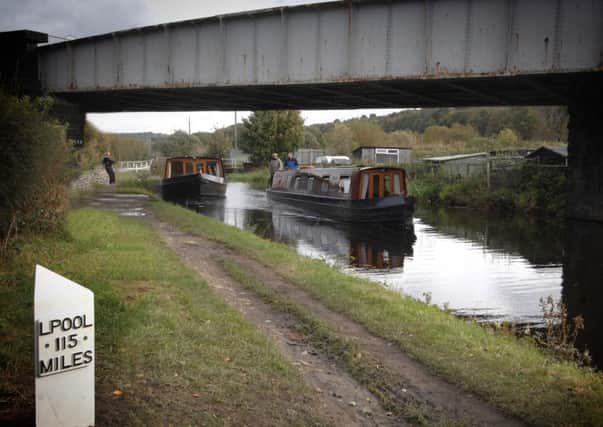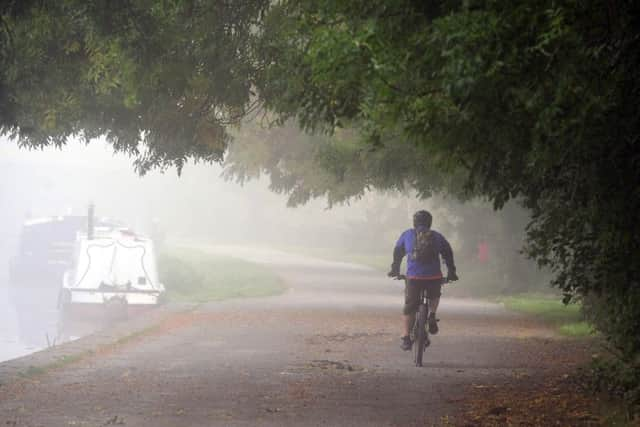Leeds nostalgia: Miles and bits of miles on Leeds Liverpool Canal


In fact, the distances are marked starting at the Liverpool end; and so each milepost shows whole number of miles from Liverpool but a whole number plus a quarter from Leeds. And when the system was installed, after a survey, in the 1890s there were included (some still surviving today) a half-mile post and two quarter- mile posts between each two mile posts.
From the later 18th century through into the 19th when the canal system carried the life blood of the Industrial Revolution throughout England and Wales, and these distance posts were installed, this accuracy was important.
Advertisement
Hide AdAdvertisement
Hide AdThe canal was essential to the growth and profit of the new industries: to take raw materials to the furnaces and factories; its finished goods to national and international markets.


Today, watching a pleasure boat chugging down the canal, it is hard to believe; but (at least until the railways gradually took over later in the 19th century) with no railway, no motorway, no airway, accuracy and efficiency of the canal system was important.
Each canal’s private proprietor had much of a monopoly of its particular route; here the route between Liverpool and Leeds, on to the seaport at Hull, serving all the industries on the way.
Regulation of that monopoly was essential in the interest of the country’s industrial entrepreneurs; and such detailed regulation was indeed provided by the government, through Parliament and the Railway and Canal Commission.
Advertisement
Hide AdAdvertisement
Hide AdAny regulation of the carriage of goods and control of its tolls requires accurate identification and classification of the particular goods to be carried; accurate measure of the quantity of those goods; and accurate measurement of the distance they were to be carried.


An Act of Parliament of 1893 is entitled: ‘Canal Rates Tolls and Charges (Leeds and Liverpool Canal) Order Confirmation Act’. This Act left little room for haggling between the canal company and the owners of the goods to be carried on its canals.
Let me quote from the Act to illustrate how detailed was that regulation.
It reads: “16. For a fraction of a penny in the gross amount of rates, tolls, and charges for any consignment for the entire distance conveyed, the Company may charge a penny.”
Advertisement
Hide AdAdvertisement
Hide AdAnd... “18. All stone, when conveyed by the Company, shall be charged by weight when the weight can be conveniently ascertained.
“When the weight of the stone in blocks cannot be conveniently ascertained, 14 cubic feet of stone in blocks may be charged for as one ton, and smaller quantities may be charged for in the like proportion.”
To read the full article, visit our website and click under ‘Nostalgia’.
The toll depended in part on the category to which cargo was belonged. It would have to be placed into one of eight categories and under the correct heading in that category. To give a brief illustration of the hundreds of possible categories listed in the schedule to the Act: “Class B included, illustrating incidentally the growing complexity of an industrial society and the health and labour implications for the boatman and his family living and working aboard: ‘Alabaster stone, in lumps, unground. Ammoniacal liquor. Antimony ore waste. Asphalte paving in blocks. Barytes, raw, in bulk. Basic material, burnt limestone, in bulk, to steel convertors. Basic slag, ground, packed. Blooms, billets or ingots, iron or steel. Bog-ore for gas purifying. Bricks, clay, common and fire. Bricks crushed.”
And so on.
Advertisement
Hide AdAdvertisement
Hide AdAnd the toll depended further on the distance to be carried. For example, goods in category A could be charged at a maximum of 90 d per ton per mile for the first ten miles or part thereof; 80 d per ton per mile for the next ten miles or part thereof; 70 d per ton for the next ten miles or part thereof and 60 d per ton per mile for the remainder of the distance.
And so on.
This meant, of course, that an accurate measure of mileage all along the canal had to be available; and, although not specifically required by the legislation, that a company such as the Leeds and Liverpool did in the 1890s install such a system.
As to the half and quarter-mile distance posts: they were used by the legislation itself. Hence the need for half and quarter-mileposts. Thus: “15. For a fraction of the first mile the company may charge as for a mile, and for a fraction of a mile after the first mile the Company may charge according to the number of quarters of a mile in that fraction, and a fraction of a quarter of a mile may be charged for as a quarter of a mile.”
This year (2016) marks the bicentenary of the completion of the Leeds & Liverpool Canal. This system of distance posts is embedded in its history. It is fitting that the Canal & River Trust planning as part of the celebrations to restore at least some of the mileposts ‘replacing those that are missing, potentially repairing existing but damaged posts, or simply repainting them.